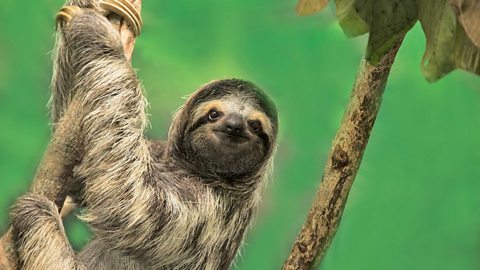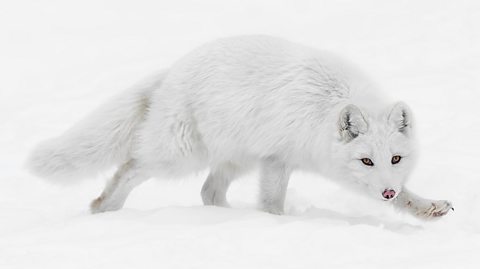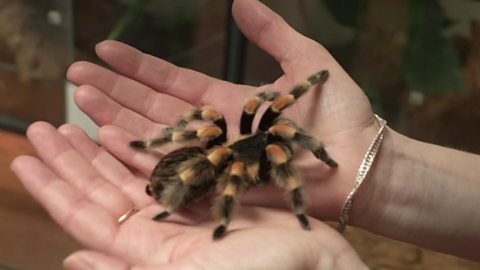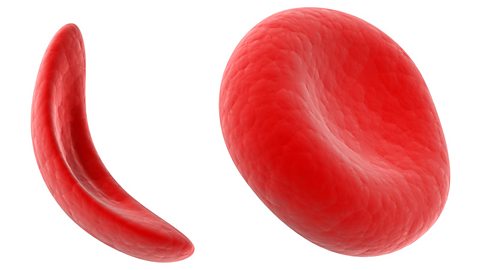Key points
- The adaptations of organisms allow them to thrive in different habitats, including extreme environments.
- Evolution explains how better adapted organisms have an advantage and are more likely to have offspring with this same adaptation.
Adaptations of animals
Video
NARRATOR: Do you notice anything unusual about this salamander?
If you need a clue – in this cave there is usually no light. This is a Texas blind salamander, a type of salamander that has no eyes. In the perpetual darkness of the caves where it lives they are of no use – instead its other senses have become highly developed. It can detect any movement in the water it is completely aware of its surroundings, but all without eyes.
By losing its eyes and developing other senses the Texas blind salamander has adapted to its environment.
All over the planet, plants and animals adapt to the challenges of their own habitat. These distant fox cousins range from the frozen north of the arctic to the heat of the African and everywhere in between – including your own street or back garden.
Yes – I’m talking about you.
In the distant past these foxes would all have shared a common ancestor, but now they are all adapted to their local habitat.
Can you spot how these animals differ from each other and why they have developed these differences?
The arctic fox has darker fur in the summer months, but when winter comes it has developed this pure white coat to help it blend into the snow while scavenging and hunting. The fur is also thick and warm to cope with the extreme cold.
What a pair of ears. I should probably talk quietly. But in fact, although foxes do have very good hearing that is not the only reason why these desert foxes have such huge ears. It's also to keep cool.
The desert fox's amazing ears help keep it cool by helping it to lose heat more quickly. Also notice how the coat is much thinner than that of its arctic cousin. In the scorching desert, this fox has adapted to stay as cool as possible. This is why the desert fox is also most active at night. Nights in the desert can be very cool and it's a time when many small desert animals are active. A perfect time for hunting.
Nothing happening here.
But in nature things are not always what they seem. Many animals have adapted to use camouflage to hide and blend into their surroundings. Camouflage can be used as a form of defence to help hide from predators. But it can also be used to help catch prey.
Probably the undisputed master of camouflage in the whole animal kingdom is the amazing cuttlefish. The cuttlefish can change both the colour and texture of its skin to match any environment. And these incredible transformations can all happen in the blink of an eye.
There are amazing examples of camouflage everywhere in nature, but how did these incredible creatures develop this impressive talent?
Offspring are not identical to their parents. Even if it is a very small difference there is variation from one generation to the next. The better the camouflage of the offspring, the harder it is for them to be seen by predators or prey, and the more likely it is that they will survive and reproduce.
Here is a simple example.
These moths are from the same parents. Some are dark, some are light. In the local environment, the darker moths will be more easily seen by predators and will be less likely to survive. The lighter moths are more likely to reach adulthood and reproduce. When they do they will be more likely to produce more lighter coloured offspring, so after several generations the number of lighter moths will be higher than the darker moths. This is how a species can adapt and develop over time to match their environment.
This is also true for animals that use camouflage to hunt. The better they are at hiding, the more successful they will be at catching food and surviving, and the more offspring they will produce.
So through variation we can see how over time a species can evolve and adapt to their environment. Animals that are better adapted to their environment will be more successful in surviving and reproducing.
This is a key part of what we call natural selection. And natural selection is a key part of evolution. Which is what we call it when species change and develop over time.
Can you answer these questions based on the video?
1. Why doesn’t the Texas cave salamander have eyes?
2. Apart from hearing, why do desert foxes have large ears?
Because they live in dark caves and so don’t need to be able to see.
To keep cool.
Examples of adaptation
Adaptations are features of living organisms that help them survive. These can be to do with their physical appearance - structural adaptations - or they can be behavioural adaptations, which affect what the organisms do.
Adaptations can also be physiologicalA body process that helps an organism to survive/reproduce.. A good example of this type of adaptation is the production of poison.
Animals have a wide range of adaptations. Rainforests have some of the greatest biodiversityA measure of the range of living organisms within a habitat. of animals on Earth.
Tap through the slideshow to see some rainforest animals and their adaptions.

Image caption, The sloth is well camouflaged and moves slowly which makes it difficult for predators to spot. This also means it uses little energy.
Image caption, The spider monkey has long, strong limbs to help it climb through the rainforest trees to find food and mates.
Image caption, The toucan has a long, large bill to allow it to reach and cut fruit from branches which are too weak to support its weight.
Image caption, The flying frog has fully webbed hands and feet and a flap of loose skin that stretches between its limbs, which allows it to glide from plant to plant.
1 of 4
Quiz - Adaptions of camels
Evolution and extinction
Variation is the slight changes in some organisms of the same speciesA group of organisms that can interbreed to have fertile offspring.. These tiny differences might give some organisms slightly better features and so make it more likely that they survive and have offspring with these same adaptations. Over time this process gives rise to new species of organisms. This is called evolutionThe process by which small changes in organisms occur over long periods of time and new species are formed..
Variation can be caused by small changes in DNA called mutations. Most of these have no effect, some are advantageous and some are disadvantageous.
Extinction occurs when all organisms of a species die out. This may be because the organisms were not able to adapt to changing conditions fast enough. Evolution is a slow process and usually takes many generations. Extinction can be for other reasons than evolution. Many are caused by humans. For example hunting, destruction of habitats and global warming.
Adaptations of plants

Plants also have a wide range of adaptations. In rainforests there is a huge diversity of plants, many not yet identified by humans.
Many trees in the rainforest have tall, thin trunks to allow them to quickly grow towards the light.
Lots of plants have smooth trunks and stems, and drip tips to their leaves to allow water to run off without damaging the plant.
Some trees have large buttress roots which anchor them into the ground meaning they can grow very tall.
Other plants called epiphytes grow on the higher branches of trees and get their water and nutrients from the air, not their roots. They grow here to absorb more light for photosynthesisA chemical reaction that occurs in the chloroplasts of plants in which the energy in light is stored in glucose..

Adaptations of extremophiles
Extremophiles are organisms that live in extreme environments. These places have conditions outside of the normal range that most life can live in. Deserts are extreme environments because of the heat during the day, cold at night and lack of water.
Deserts

The cactus is an example of a plant which is able to survive in deserts with extremes of temperature and a lack of fresh water. They have:
- Stems that can store water.
- Widespread or very deep root systems that can collect water from a large area or from very deep underground.
- Spines which prevent the plant being eaten.
- The spines are modified leaves. These minimise the surface area and so reduce water loss.
- Very thick, waxy cuticleA waxy later on the outside of plant leaves and stems to reduce water loss. to reduce water loss.
- Reduced number of pores called stomataTiny pores found most commonly on the bottom of leaves to allow gases to move in and out for photosynthesis and respiration. to reduce water loss.

Volcanic vents
There are volcanic vents at the bottom of the oceans where it is so dark that no plant or alga could live. These are extreme environments because of cold temperatures and high pressures.
Places like this are home to the only food webA diagram which shows all the interlinked food chains in a habitat. on Earth that don’t start with photosynthesis. The producerThe first organism in a food chain. Usually a green plant or alga which stores energy from sunlight as glucose during photosynthesis. are bacteria that feed directly on the chemicals released from the vents, which is used to make glucose. This process is called chemosynthesis.
Polar regions

The Polar regions are also extreme environments because of the cold temperatures and lack of liquid fresh water. Polar bears are adapted to live in the Arctic. They hibernate through the most severe months and have:
- Thick white fur for camouflage.
- Greasy fur to remove water quickly after swimming.
- A thick layer of fat to keep warm.
- Sharp teeth and claws for hunting.
- Large feet to spread their weight on the snow and ice.

Test your knowledge
Quiz - Adaption of animals and plants
Test questions
This is an Arctic fox. From looking at the picture, what adaptions do you think this species has?

- White fur (in winter) for camouflage
- Thick fur to keep warm
- Sharp claws for hunting
- Good hearing to find prey in the snow
- Small ears to reduce heat loss
Play the Atomic Labs game! gamePlay the Atomic Labs game!
Try out practical experiments in this KS3 science game.

More on Inheritance and genetics
Find out more by working through a topic
- count6 of 11

- count7 of 11

- count8 of 11

- count9 of 11
